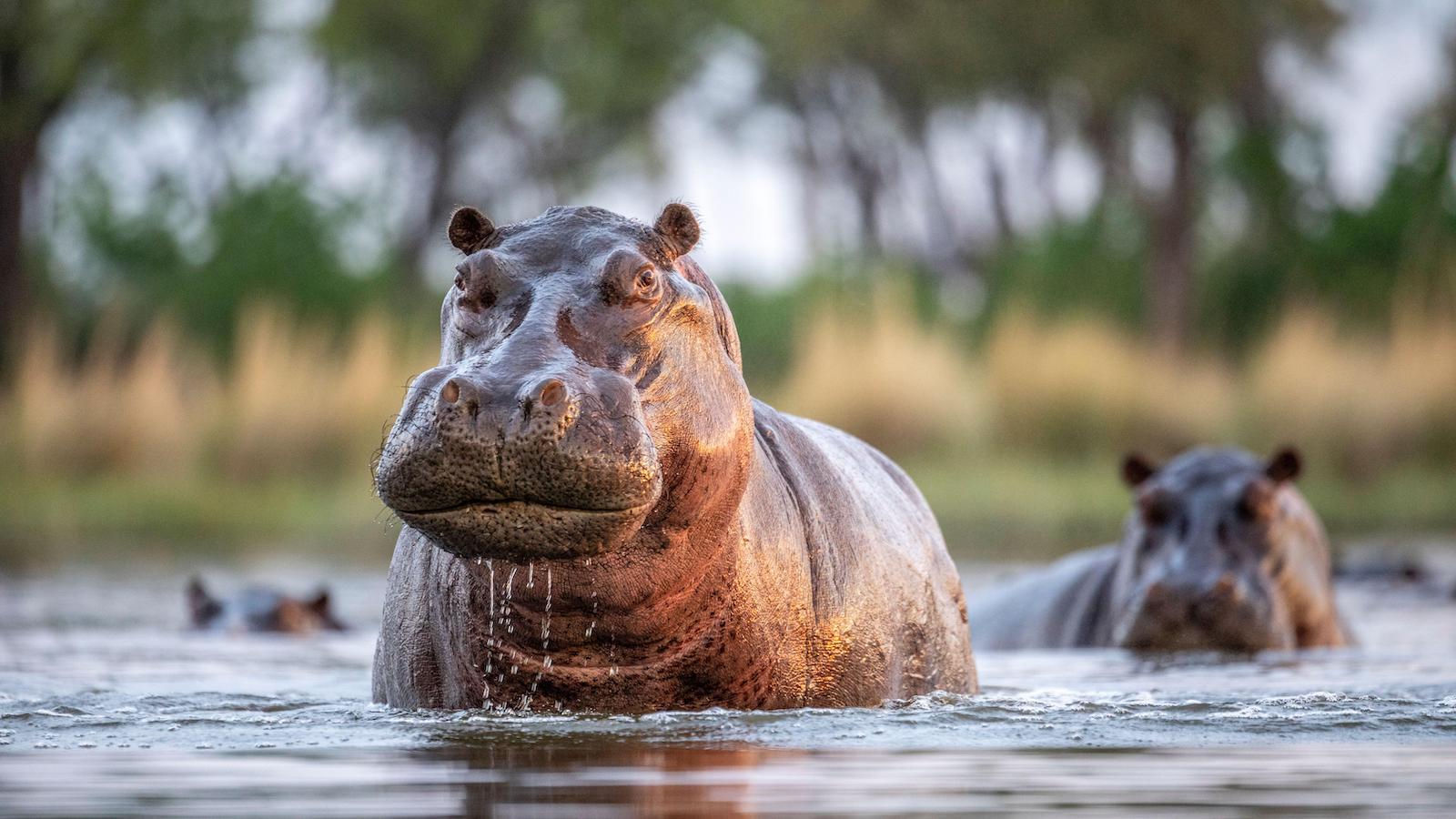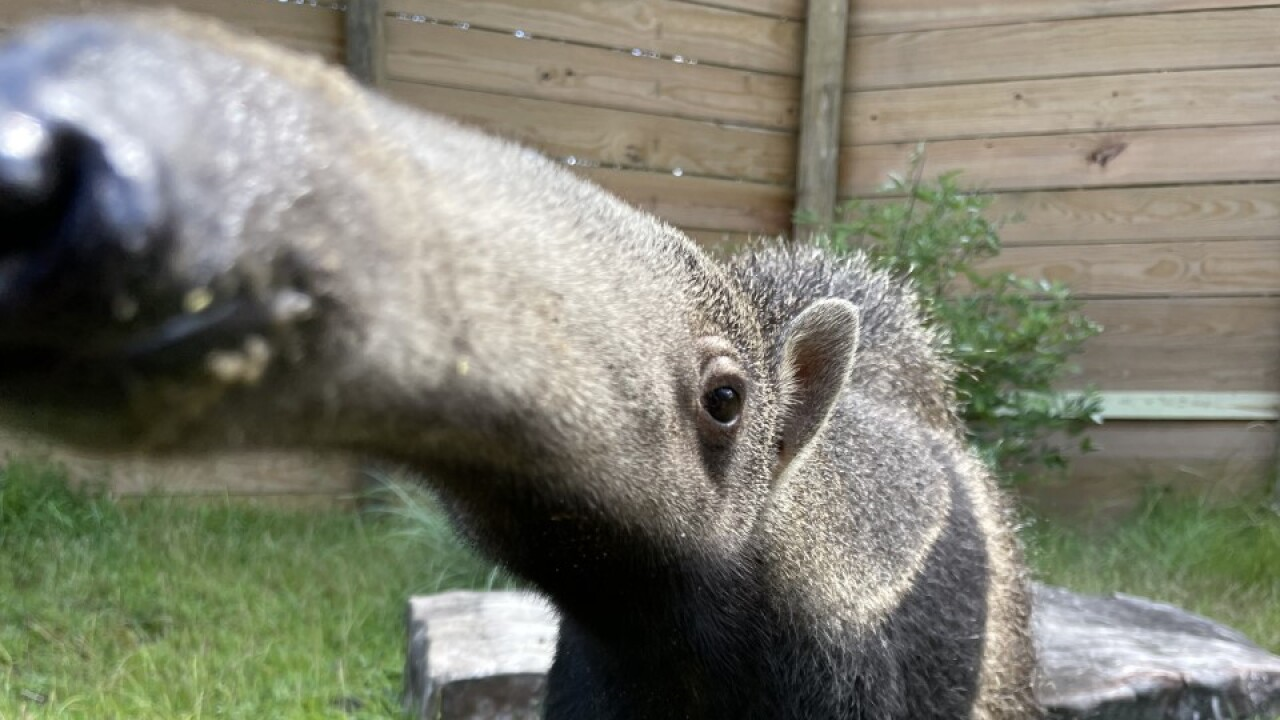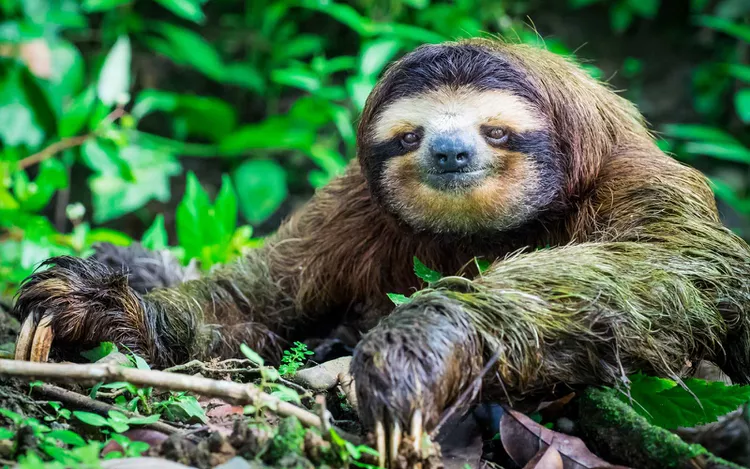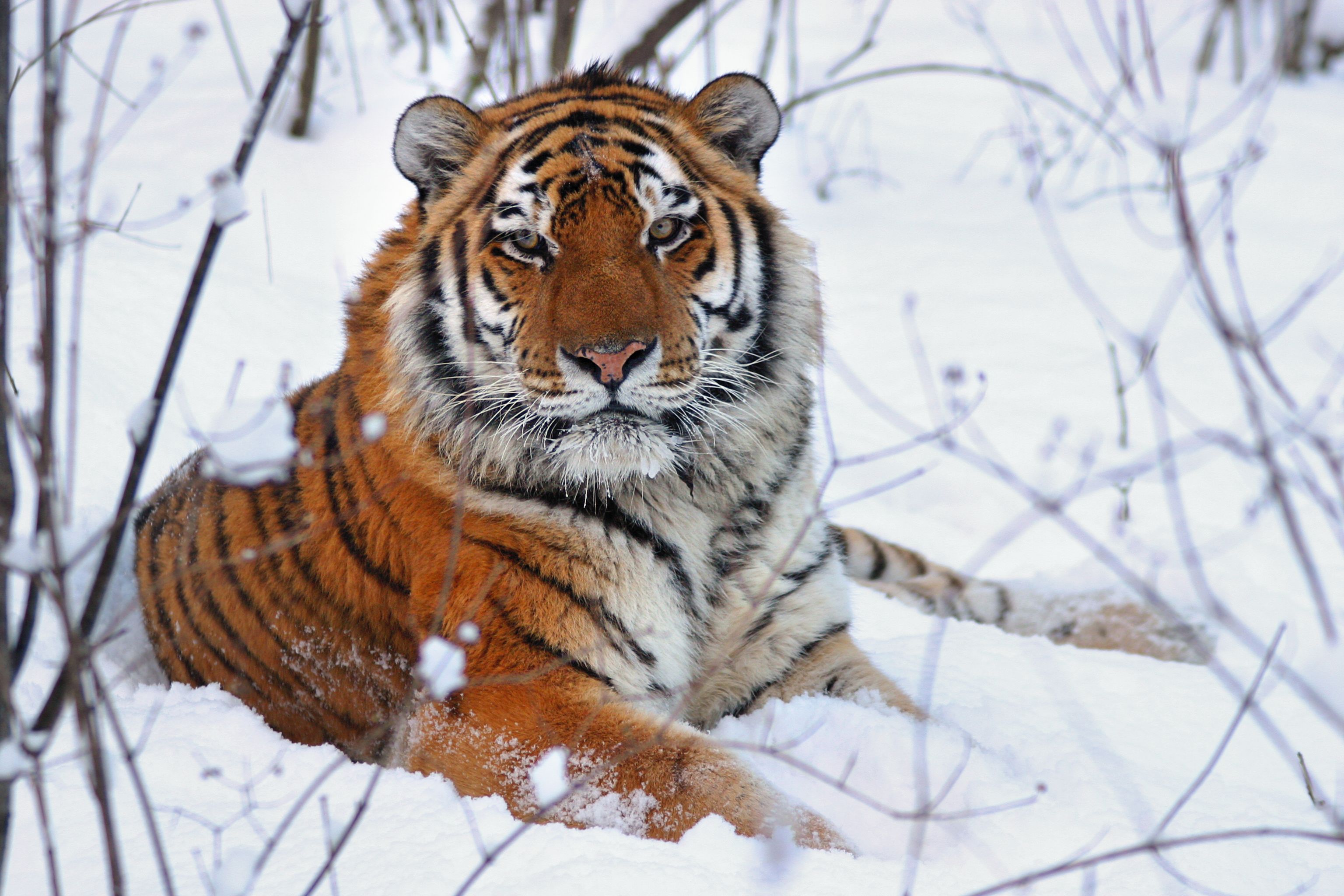The Top 10 List of Animals With Incredibly Long Tongues
Here are ten animals with notably long tongues:
-
"Geckos are like the ninjas of the lizard world – silent, swift, and always sticking to the wall when you least expect it."
Chameleons have long, extendable tongues that they use to capture prey, such as insects. The tongue can be longer than the chameleon's body and is rapidly projected to catch prey.
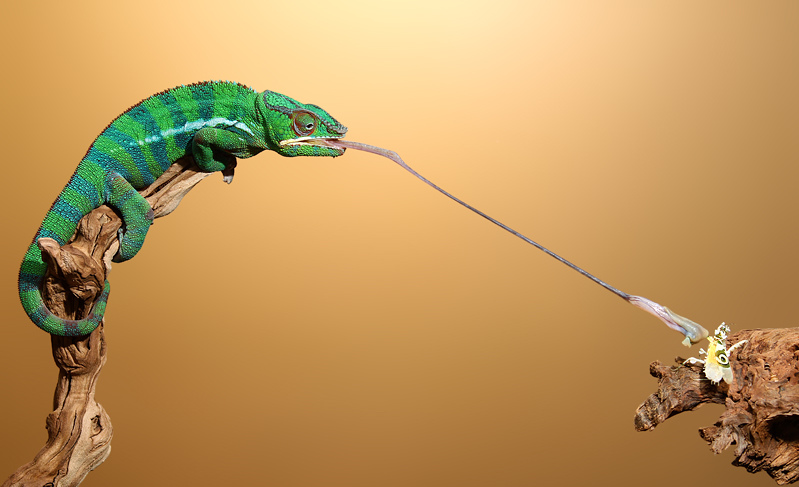
"I asked my gecko for relationship advice. He just stuck to the wall and looked at me like, 'Stick to what works, mate.'"
Chameleons are fascinating creatures known for their ability to change color, but their hunting techniques are equally intriguing. Here's an overview of how chameleons hunt:
-
Ambush Predators: Chameleons are primarily ambush predators. They use their incredible camouflage skills to blend into their surroundings, making them nearly invisible to prey. By staying motionless and patiently waiting, they can surprise unsuspecting insects that come too close.
-
Projectile Tongue: One of the most remarkable features of chameleons is their long, extensible tongue. When hunting, a chameleon focuses on its prey with both eyes. It then rapidly extends its tongue, which can be longer than the chameleon's body, to capture insects from a distance. The tongue is sticky and wraps around the prey, allowing the chameleon to reel it back in.
-
Accurate Aim: Chameleons possess exceptional depth perception and binocular vision, thanks to their independently moving eyes. This allows them to accurately judge the distance to their prey. Before striking, a chameleon may move its eyes independently to focus on the target, ensuring a precise and successful tongue strike.
-
Patience: Chameleons are patient hunters. They can remain motionless for extended periods, waiting for the right moment to strike. This ability to stay still, combined with their camouflage, makes them highly effective at ambushing prey.
-
Nocturnal Hunting: While some chameleon species are diurnal (active during the day), others are nocturnal. Nocturnal chameleons use their excellent night vision to hunt for prey in low light conditions. Their hunting techniques may differ slightly from their diurnal counterparts, but they still rely on their remarkable eyesight and tongue-projection abilities.
-
Diet: Chameleons primarily feed on insects, such as crickets, grasshoppers, and other small invertebrates. Some larger chameleon species may also consume small vertebrates like lizards and birds.
-
-
Giant anteaters (Myrmecophaga tridactyla) are fascinating creatures with several interesting features:
-
Unique Appearance:
- Giant anteaters have a distinctive appearance with a long snout and a bushy tail.
- They are easily recognizable by their black, white, and gray fur, often with a diagonal stripe pattern on their bodies.
-
Long Tongue:
- Giant anteaters have an exceptionally long tongue, which can measure up to two feet (61 cm).
- Their tongue is covered in tiny, hook-like structures and is used to lap up insects with incredible speed.
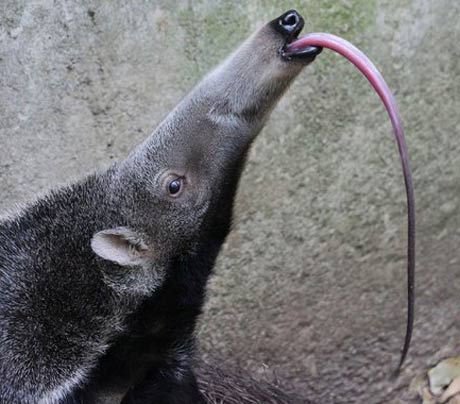
-
Diet and Feeding Habits:
- As their name suggests, giant anteaters primarily feed on ants and termites. They can consume up to 30,000 insects in a single day.
- Their strong forelimbs and sharp claws are adapted for tearing open termite mounds and ant nests.
-
Terrestrial Lifestyle:
- Giant anteaters are mainly terrestrial and spend most of their time on the ground. They are not skilled climbers and usually avoid trees.
-
Excellent Sense of Smell:
- They have a keen sense of smell, which they use to detect ant and termite colonies.
- Their sense of smell is estimated to be 40 times better than that of humans.
-
Low Reproductive Rate:
- Giant anteaters have a relatively slow reproductive rate. Females usually give birth to a single offspring after a gestation period of about 190 days.
-
Protective Behavior:
- When threatened, giant anteaters can display defensive behaviors, including standing on their hind legs to use their powerful forelimbs and sharp claws for protection.
-
Habitat and Range:
- They are native to Central and South America, inhabiting grasslands, savannas, and rainforests. They are most commonly found in areas with sufficient ant and termite populations.
-
Conservation Concerns:
- Giant anteaters face threats from habitat loss due to deforestation, as well as being victims of roadkill accidents. They are listed as "Vulnerable" on the International Union for Conservation of Nature (IUCN) Red List.
-
Communication:
- While generally solitary animals, giant anteaters communicate through various vocalizations, including snorts, grunts, and hisses.
These features make giant anteaters intriguing creatures with unique adaptations to their environment and specialized feeding habits. Conservation efforts are crucial to ensure their survival in the wild.
-
-
"Why did the bat join a baseball team? He had the best 'bat'-ting average in town!"
The Tube-lipped Nectar Bat (Anoura fistulata) is a fascinating bat species known for its unique and specialized feeding adaptations. Here are some interesting features about the Tube-lipped Nectar Bat:
-
Remarkable Tongue Length:
- The Tube-lipped Nectar Bat has an exceptionally long tongue, extending up to twice the length of its body. This adaptation allows it to reach deep into long-tubed flowers to extract nectar.
-
Specialized Feeding on Long-Tubed Flowers:
- This bat species is highly specialized in feeding on flowers with long tubular structures. It co-evolves with certain plant species, and its long tongue helps it access nectar from flowers that other bats may find challenging to feed on.

- This bat species is highly specialized in feeding on flowers with long tubular structures. It co-evolves with certain plant species, and its long tongue helps it access nectar from flowers that other bats may find challenging to feed on.
-
Pollination Role:
- Similar to other nectar-feeding bats, the Tube-lipped Nectar Bat plays a crucial role in pollination. As it feeds on nectar, it inadvertently transfers pollen from one flower to another, facilitating the reproductive process of various plants.
-
Distribution:
- The Tube-lipped Nectar Bat is found in the cloud forests of Ecuador and Colombia in South America. It inhabits montane forests at higher elevations.
-
Nocturnal Behavior:
- Like many nectar-feeding bats, the Tube-lipped Nectar Bat is nocturnal, being most active during the night. It relies on echolocation to navigate and locate flowers.
-
Social Behavior:
- These bats are known to be social and often roost in groups. Social roosting can offer advantages such as sharing information about food sources and protection from predators.
-
Unique Tube-Like Nose Structure:
- The Tube-lipped Nectar Bat's scientific name, "fistulata," refers to its tube-like nose structure. The bat's nose is elongated and tubular, contributing to its specialized feeding adaptations.
-
Conservation Concerns:
- Due to its limited geographic range and specific habitat requirements, the Tube-lipped Nectar Bat may be vulnerable to habitat loss and climate change. Conservation efforts are essential to protect its unique ecosystem.
-
Scientific Discovery:
- The Tube-lipped Nectar Bat was described as a new species in 2005, highlighting the ongoing discovery of new species and the importance of conservation efforts to protect biodiversity.
The Tube-lipped Nectar Bat's distinctive adaptations for feeding on long-tubed flowers make it a remarkable example of co-evolution between bats and plants. Studying such species provides valuable insights into the intricate relationships between different organisms in their ecosystems.
-
-
"Why did the woodpecker join a jazz band? Because he had the best drumming skills in the forest!" hahaha
Woodpeckers are fascinating birds with several unique features and adaptations. Here are some interesting aspects about woodpeckers:
-
Specialized Anatomy:
- Woodpeckers have a strong, chisel-like beak that is adapted for drilling into wood. Their skulls are uniquely designed to absorb the shock of repeated pecking, minimizing the risk of brain injury.
-
Drumming Communication:
- Woodpeckers engage in drumming, a behavior where they rapidly tap on a resonant surface (usually a tree) to communicate with other woodpeckers. Each species may have a distinct drumming pattern.

- Woodpeckers engage in drumming, a behavior where they rapidly tap on a resonant surface (usually a tree) to communicate with other woodpeckers. Each species may have a distinct drumming pattern.
-
Feeding Behavior:
- Woodpeckers primarily feed on insects, larvae, and other invertebrates found beneath the bark of trees. They use their beaks to create holes and extract prey.
-
Tongue Adaptations:
- Woodpeckers have long, barbed tongues that they use to extract insects from crevices in wood. The tongue can be extended significantly, aiding in capturing prey.
-
Zygodactyl Feet:
- Woodpeckers have zygodactyl feet, meaning two toes point forward, and two toes point backward. This foot arrangement provides a strong grip on vertical surfaces such as tree trunks.
-
Nesting in Tree Cavities:
- Many woodpecker species excavate cavities in trees for nesting. After the nesting season, these cavities may be used by other birds and animals for shelter.
-
Vivid Plumage:
- Woodpeckers often display striking plumage, with various patterns of black, white, and red. These colors may serve both for camouflage and visual communication.
-
Territorial Behavior:
- Woodpeckers are territorial birds and often communicate their presence through vocalizations and drumming. They may engage in aggressive behavior to defend their territory.
-
Migration Patterns:
- While some woodpecker species are sedentary, others may undertake seasonal migrations in search of food sources.
-
Conservation Role:
- Woodpeckers contribute to forest health by controlling insect populations. Their foraging activities help to keep tree-damaging insects in check.
-
Acorn Storage:
- Some woodpecker species, like the Acorn Woodpecker, are known for storing acorns in tree bark crevices, creating "granary trees." These stored acorns serve as a winter food supply.
-
Clever Tool Use:
- Woodpeckers are known to use tools, such as twigs, to extract insects from tree bark. This behavior demonstrates their problem-solving abilities.
Observing woodpeckers in their natural habitats showcases their remarkable adaptations for a specialized lifestyle centered around foraging in trees.
-
-
"Why did the Honey Possum get a job as a comedian? Because it had the sweetest punchlines and a tongue-twisting sense of humor that could make any flower burst into laughter!"
The Honey Possum (Tarsipes rostratus) is a unique and fascinating small marsupial found in southwestern Australia. Here's an interesting feature about the Honey Possum:
Specialized Diet:
- The Honey Possum is highly specialized in its diet, primarily feeding on nectar and pollen from various flowering plants.
- It has a long, brush-tipped tongue that it uses to extract nectar from flowers. The tongue is around twice the length of its body, allowing it to access nectar from deep within flowers.
- Despite being classified as a marsupial, the Honey Possum has evolved a diet more commonly associated with some species of birds, such as hummingbirds.
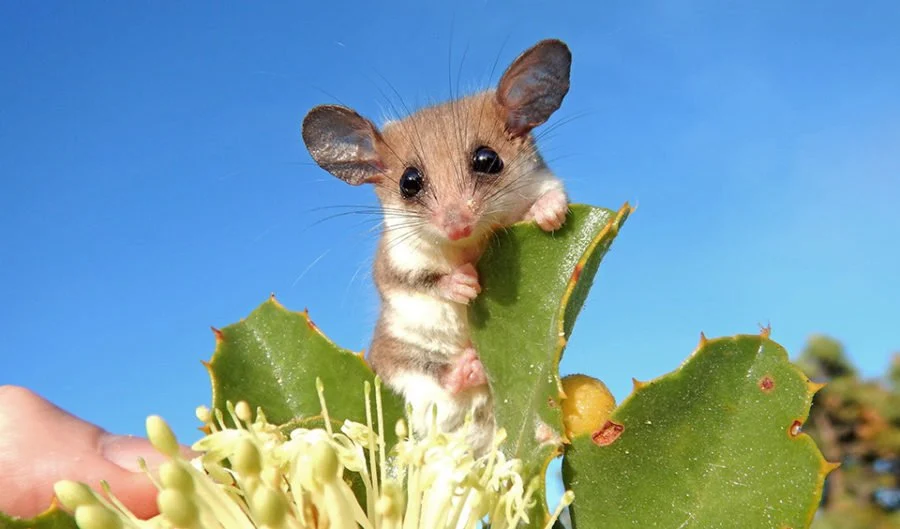
This unique dietary adaptation makes the Honey Possum an important pollinator in its ecosystem, as it transfers pollen from one flower to another while feeding. The relationship between the Honey Possum and flowering plants is an example of coevolution, where both the animal and the plants benefit from their interactions.
Conservation efforts are crucial to protect the habitats of the Honey Possum, as its specialized diet and role as a pollinator make it susceptible to changes in the availability of flowering plants in its native region.
-
"Why did the Okapi bring a map to the jungle? Because it wanted to find its own 'spot'-acular way without getting too 'spotted' along the journey!"
The okapi, a relative of the giraffe found in Central Africa, has a long, prehensile tongue that it uses to strip leaves from trees and bushes.
The okapi (Okapia johnstoni) is a fascinating and relatively lesser-known animal. Here are some interesting characteristics about okapi:
-
Unique Appearance:
- Okapis have a unique appearance with their brownish-red coat, horizontal white stripes on their legs, and a horse-like body shape. This distinctive coloration helps them blend into their dense forest environment.
-
Closely Related to Giraffes:
- Despite their appearance, okapis are more closely related to giraffes than to zebras, despite sharing a resemblance to both.
-
Forest Dwellers:
- Okapis are found in the dense, tropical rainforests of central and northern Congo in Africa. They primarily inhabit the dense undergrowth and are well-adapted to this environment.

- Okapis are found in the dense, tropical rainforests of central and northern Congo in Africa. They primarily inhabit the dense undergrowth and are well-adapted to this environment.
-
Solitary Behavior:
- Okapis are mostly solitary animals, and they mark their territory using scent glands on their feet. They communicate with each other through vocalizations and infrasound, which are sounds below the human range of hearing.
-
Herbivorous Diet:
- Okapis are herbivores and mainly feed on leaves, buds, fruits, and other vegetation. They use their long, prehensile tongue (up to 18 inches) to strip leaves and buds from trees and shrubs.
-
Elusive Nature:
- Due to their secretive and elusive nature, okapis were not officially known to the Western world until the early 20th century. They were often referred to as the "African unicorn" due to their rarity and elusive behavior.
-
Conservation Status:
- Okapis are currently listed as endangered on the International Union for Conservation of Nature's (IUCN) Red List. Their populations are threatened by habitat loss due to logging, as well as poaching for their meat and skin.
-
Short Gestation Period:
- Okapis have a relatively short gestation period of around 440 to 450 days. This is a notable characteristic considering their large size.
-
Camouflage Adaptations:
- The coloration and markings on an okapi's legs are believed to serve a camouflage function in the dappled light of the forest, helping them blend in and avoid predators.
-
Conservation Efforts:
- Conservation efforts are underway to protect okapi populations and their habitats. National parks and reserves have been established to safeguard these unique creatures, although ongoing challenges such as illegal logging and hunting persist.
Learning more about the okapi and supporting conservation initiatives can contribute to the preservation of this intriguing species.
-
-
"Why do giraffes have such long necks? Because they can't stand short jokes!"
Giraffes have long, dark tongues, often over 18 inches (45 cm), which they use to reach high branches and strip leaves from trees.
Giraffes are fascinating creatures with several interesting characteristics:
-
Tallest Land Animals:
- Giraffes hold the title of the tallest land animals, with an average height ranging from 15 to 18 feet (4.5 to 5.5 meters). Their long necks and legs contribute to their impressive stature.
-
Distinctive Spots:
- Each giraffe has a unique pattern of spots on its coat. No two giraffes have the exact same spot pattern, which makes it easier for researchers and wildlife enthusiasts to identify individuals.
-
Long Neck, Long Tongue:
- The giraffe's long neck, which can be up to 6 feet (1.8 meters) in length, allows them to reach high branches for food. Their tongues are also exceptionally long (up to 18 inches or 45 centimeters) and prehensile, helping them grasp and pull leaves from branches.
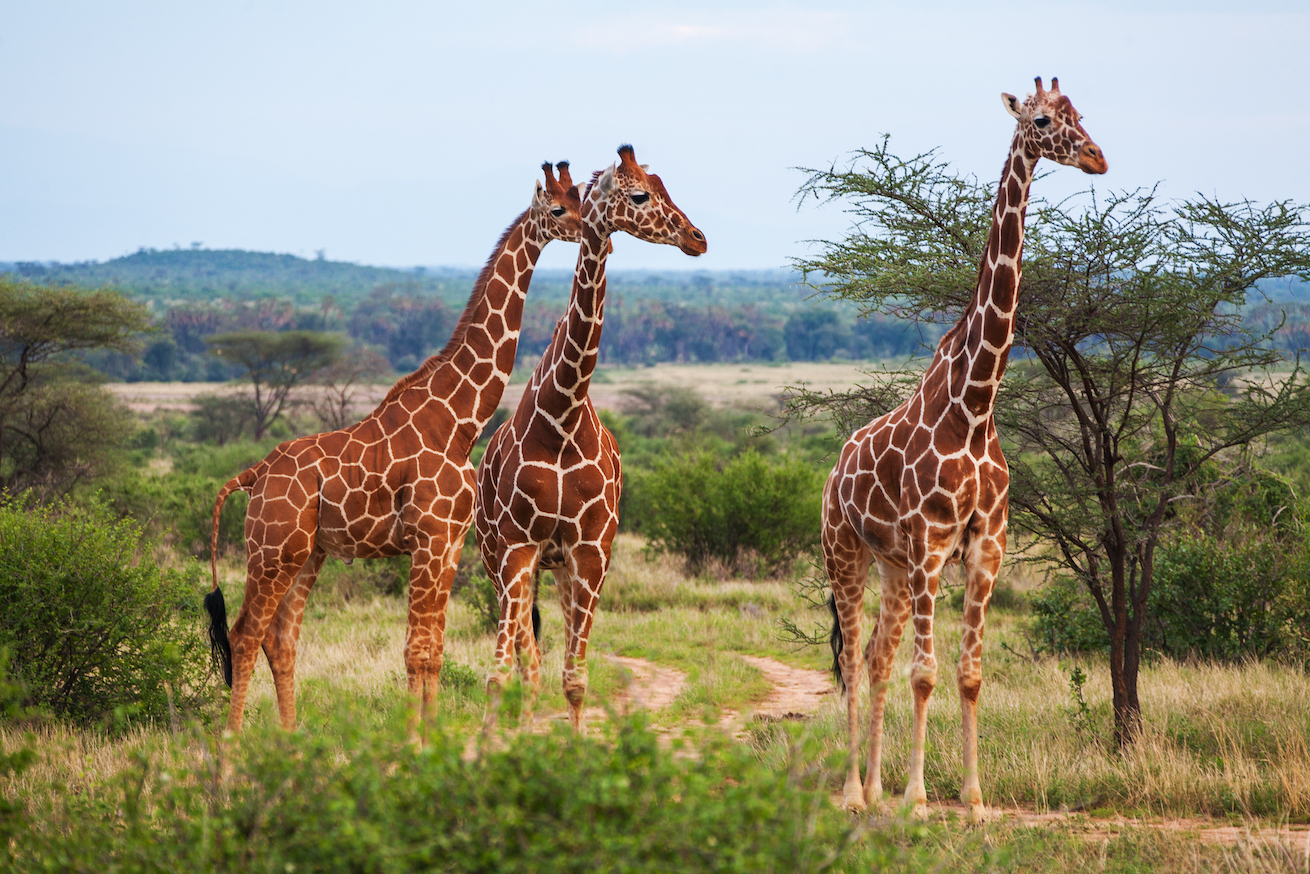
- The giraffe's long neck, which can be up to 6 feet (1.8 meters) in length, allows them to reach high branches for food. Their tongues are also exceptionally long (up to 18 inches or 45 centimeters) and prehensile, helping them grasp and pull leaves from branches.
-
Herbivorous Diet:
- Giraffes are strict herbivores, primarily feeding on leaves, buds, and fruits. Their favorite food is acacia leaves, and their specialized tongue and lips allow them to avoid thorns on these trees.
-
Unique Circulatory System:
- To maintain blood flow to their brain when they lower their heads to drink water, giraffes have a specialized circulatory system. A series of valves and elastic vessels prevent an excessive rush of blood to the head.
-
Social Animals:
- Giraffes are social animals that often gather in loose groups, called towers. These groups typically consist of females and their offspring. Male giraffes may form smaller, more transient groups.
-
Calving Behavior:
- Female giraffes give birth while standing, and the calf drops about 6 feet (1.8 meters) to the ground. This abrupt entrance into the world helps stimulate the calf's first breath.
-
Powerful Kicks:
- Giraffes have powerful hind legs and are capable of delivering formidable kicks. These kicks are often used as a means of self-defense against predators.
-
Silent Communication:
- Giraffes communicate through various means, including vocalizations such as snorts, grunts, and flute-like sounds. They also use visual cues and body language to convey information to each other.
-
Conservation Concerns:
- While giraffes are iconic and beloved animals, some species are facing threats such as habitat loss, poaching, and human-wildlife conflict. Conservation efforts are underway to protect and preserve giraffe populations.
These unique characteristics contribute to the charm and intrigue surrounding giraffes, making them a captivating species in the animal kingdom.
-
-
"Why did the numbat bring a pencil to the party? Because he wanted to draw a crowd with his spotty personality!"
Numbats (Myrmecobius fasciatus) are unique marsupials native to Australia. . The numbat, also known as the banded anteater, has a long tongue adapted for capturing termites. It can extend its tongue rapidly to catch prey.
Here are some interesting characteristics about these fascinating animals:
-
Insectivorous Diet:
- Numbats are insectivores, primarily feeding on termites. They have a long, sticky tongue (up to 10 cm) that helps them extract termites from their nests.
-
Daytime Activity:
- Unlike many other marsupials, numbats are diurnal, meaning they are active during the day. This behavior is thought to be related to their diet, as termites are most active during daylight hours.
-
Distinctive Appearance:
- Numbats have a striking appearance with a slender body, bushy tail, and a pointed snout. They are characterized by distinctive reddish-brown fur with white stripes across their back and a black stripe running down their tail.
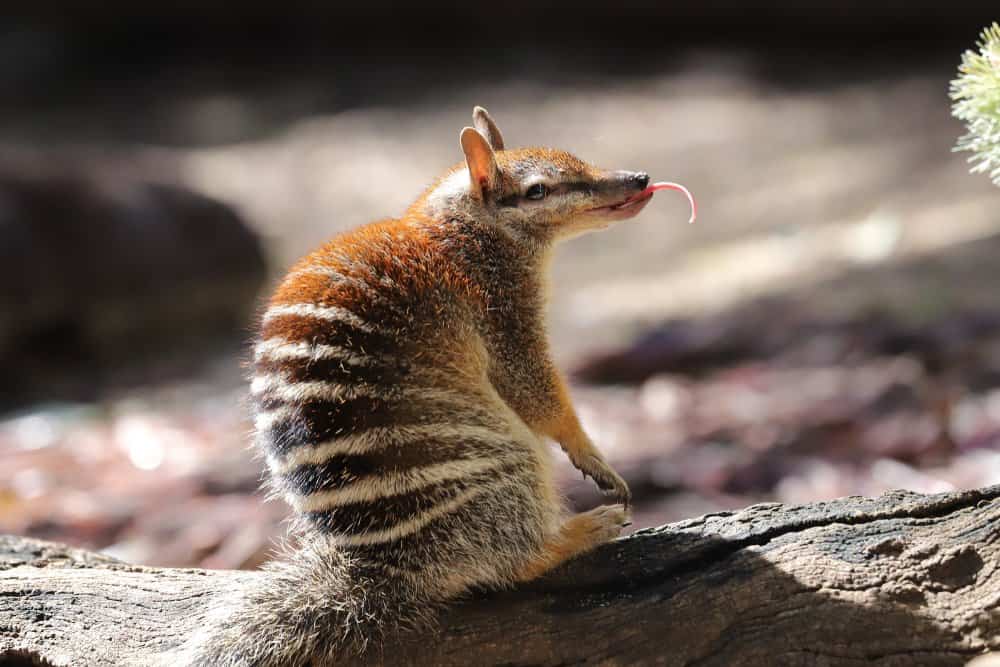
- Numbats have a striking appearance with a slender body, bushy tail, and a pointed snout. They are characterized by distinctive reddish-brown fur with white stripes across their back and a black stripe running down their tail.
-
Marsupial Pouch:
- Female numbats have a well-developed pouch, but it faces backward to prevent soil from entering when digging for termites. They typically give birth to four young, but only two survive due to the limited number of teats.
-
Specialized Teeth:
- Numbats have sharp, pointed teeth adapted for consuming termites. Their dental structure is one of the features that distinguish them from other marsupials.
-
Limited Distribution:
- Numbats were once widespread across southern Australia, but their range has significantly contracted. They are now mainly found in a few isolated pockets, primarily in Western Australia.
-
Endangered Status:
- Numbats are classified as endangered due to habitat loss, introduced predators (such as foxes and feral cats), and competition with other species for resources. Conservation efforts are in place to protect and reintroduce numbats into suitable habitats.
-
Non-Burrowing Marsupial:
- Unlike many other Australian marsupials, numbats do not burrow. Instead, they use hollow logs, fallen trees, or rock crevices as shelter.
-
Unique Locomotion:
- Numbats move in a distinctive and rapid "nosedive" motion, especially when foraging for termites. They cover the ground quickly, using their keen sense of smell to locate termite mounds.
-
Nocturnal Sleeping Habits:
- While numbats are diurnal, they are known to be crepuscular (active during dawn and dusk) and nocturnal (active during the night) sleepers, spending the night in their shelters.
The numbat's specialized diet, distinctive appearance, and endangered status make it a unique and valuable species in need of conservation efforts.
-
-
"Why did the giant hummingbird apply for a job as an air traffic controller? Because it wanted to show the little birds how to really handle high-flying traffic jams!"
The giant hummingbird (Patagona gigas), found in South America, has a long tongue that it uses to feed on nectar from flowers.. here are some interesting features:
-
Size:
- Giant hummingbirds, as the name suggests, are larger than many other hummingbird species. They can measure around 8 to 9 inches (20 to 23 centimeters) in length, making them notably larger than the more commonly known smaller hummingbirds.
-
Distinctive Appearance:
- They often have a more robust and less delicate appearance compared to smaller hummingbirds. Their plumage can vary, but some species may exhibit colorful feathers on the throat and head.
-
Habitat:
- Giant hummingbirds are typically found in the high-altitude regions of South America, including the Andes mountains. They are adapted to cooler temperatures compared to their smaller counterparts.
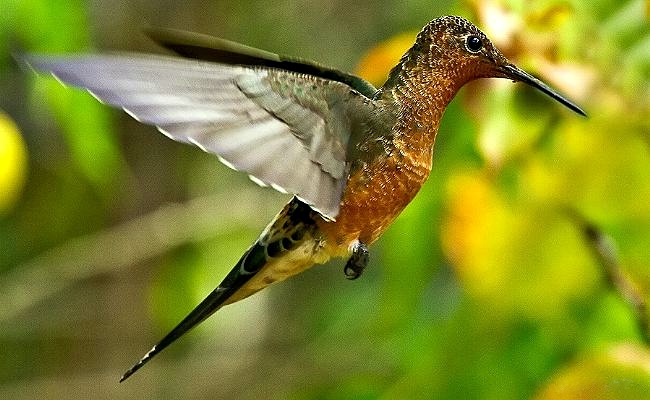
- Giant hummingbirds are typically found in the high-altitude regions of South America, including the Andes mountains. They are adapted to cooler temperatures compared to their smaller counterparts.
-
Feeding Behavior:
- Like all hummingbirds, giant hummingbirds primarily feed on nectar from flowers. However, due to their larger size, they may feed on larger flowers that are inaccessible to smaller hummingbirds. They also consume insects and spiders for protein.
-
Flapping Speed:
- Hummingbirds, in general, are known for their rapid wing beats. Giant hummingbirds maintain a relatively slower wing beat compared to smaller hummingbirds but are still incredibly agile in flight.
-
Migration:
- Some species of hummingbirds, including larger ones, may migrate seasonally in search of suitable food sources. Their migration patterns can vary based on geographical locations and environmental conditions.
-
Aggressive Behavior:
- Hummingbirds, regardless of size, can be territorial and exhibit aggressive behaviors, especially around food sources. Larger hummingbirds may have an advantage in territorial disputes due to their size.
-
Specialized Beaks:
- The beaks of giant hummingbirds are adapted for extracting nectar from larger flowers. They may also use their beaks to capture insects in flight.
-
High Metabolism:
- Like all hummingbirds, giants have a high metabolism to support their energy-intensive hovering flight. They need to consume large amounts of nectar and insects daily to sustain themselves.
-
Vocalizations:
- Hummingbirds, including larger species, may produce various vocalizations. These sounds are often used for communication and can include chirps, buzzes, and whistles.
-
-
"Why don't elephants use computers? Because they are afraid of the mouse!"
Elephants have long, muscular tongues that they use for grasping and manipulating objects, including food. They use their trunks for more complex tasks
Here are some key features that make elephants fascinating:
-
Large Size:
- Elephants are the largest land animals on Earth. They come in two main species: the African elephant and the Asian elephant. Male elephants, particularly African males, can weigh up to 14,000 pounds (6,350 kilograms).
-
Trunk Dexterity:
- The trunk of an elephant is a versatile and highly dexterous appendage. It is used for breathing, smelling, touching, grasping objects, and even producing sounds. It contains over 40,000 muscles, providing incredible flexibility and strength.
Related: The heaviest elephant in the world?
- The trunk of an elephant is a versatile and highly dexterous appendage. It is used for breathing, smelling, touching, grasping objects, and even producing sounds. It contains over 40,000 muscles, providing incredible flexibility and strength.
-
Longevity:
- Elephants have a long lifespan, often living up to 60 to 70 years in the wild. They exhibit a high level of intelligence and memory, which contributes to their ability to survive in complex environments.
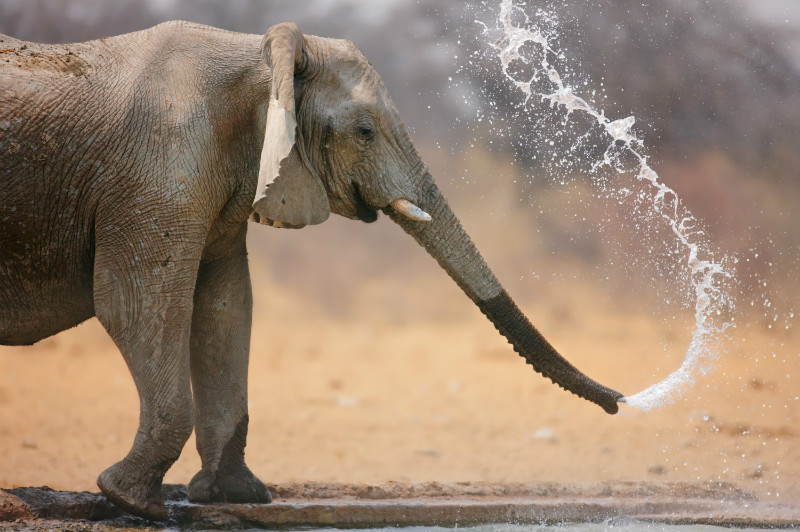
- Elephants have a long lifespan, often living up to 60 to 70 years in the wild. They exhibit a high level of intelligence and memory, which contributes to their ability to survive in complex environments.
-
Social Structure:
- Elephants are social animals with complex family structures. They live in groups called herds, led by a matriarch (usually the oldest female). The bonds within elephant families are strong, and they show signs of empathy and cooperation.
-
Communication:
- Elephants communicate using a variety of vocalizations, including trumpeting, rumbling, and purring sounds. They also use body language and touch to convey messages within their social groups.
-
Intelligence:
- Elephants are highly intelligent animals, exhibiting problem-solving skills and self-awareness. They are known to use tools, display empathy, and show signs of mourning for deceased family members.
-
Memory:
- Elephants are renowned for their exceptional memory. They can remember and recognize other individuals, recall locations of water sources, and navigate through vast territories.
-
Herbivorous Diet:
- Elephants are herbivores, mainly feeding on a variety of vegetation such as grasses, leaves, bark, and fruits. They consume large quantities of food each day to meet their energy needs.
-
Growth of Tusks:
- Both male and female elephants can have tusks, which are elongated incisor teeth. The tusks continue to grow throughout the elephant's life. Unfortunately, this has made them a target for illegal ivory trade, leading to conservation concerns.
-
Conservation Challenges:
- Elephants face significant threats from habitat loss, human-wildlife conflict, and poaching. Conservation efforts are ongoing to protect these majestic animals and ensure their survival in the wild.
-
Gentle Giants:
- Despite their large size and strength, elephants are often referred to as "gentle giants" due to their calm demeanor, especially when not threatened.
Understanding and appreciating these characteristics highlight the unique nature of elephants and the importance of conservation efforts to ensure their well-being in the wild.
-
These animals have evolved long tongues to suit their specific feeding strategies and ecological niches. The lengths mentioned are approximate and can vary among individual animals within a species. Wish you have interesting moments of discovery./.
-----------------------
Who has the longest tongue in the world?
Nick Stoeberl
Nick Stoeberl, whose tongue was officially measured at 3.97 inches from tip to teeth, was awarded the world record for longest tongue (male). Nick Stoeberl holds the record for the longest tongue.

What animal has a 2 foot long tongue?
anteaters
A giant anteater's tongue is 2 feet long and can flick in and out of its mouth 150 times per minute. It's coated in sticky saliva, which allows anteaters to slurp up ants and termites.
Which animal has a 21 inch long tongue?
Giraffes use their height to good advantage and browse on leaves and buds in treetops that few other animals can reach (acacias are a favorite). Even the giraffe's tongue is long! The 21-inch tongue helps them pluck tasty morsels from branches.
